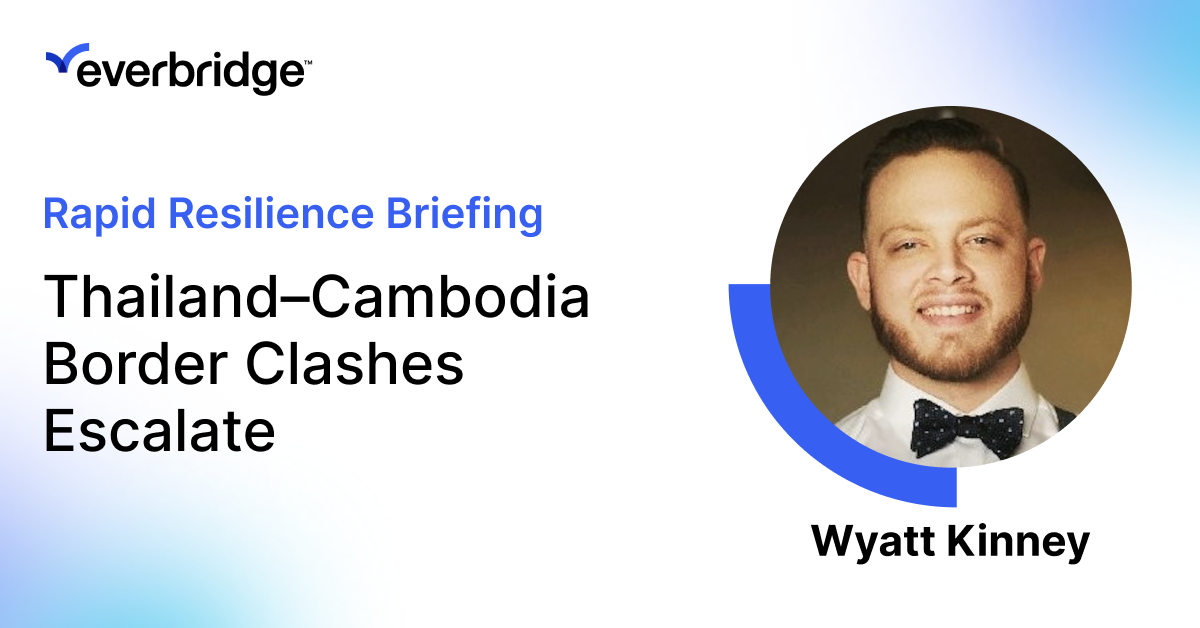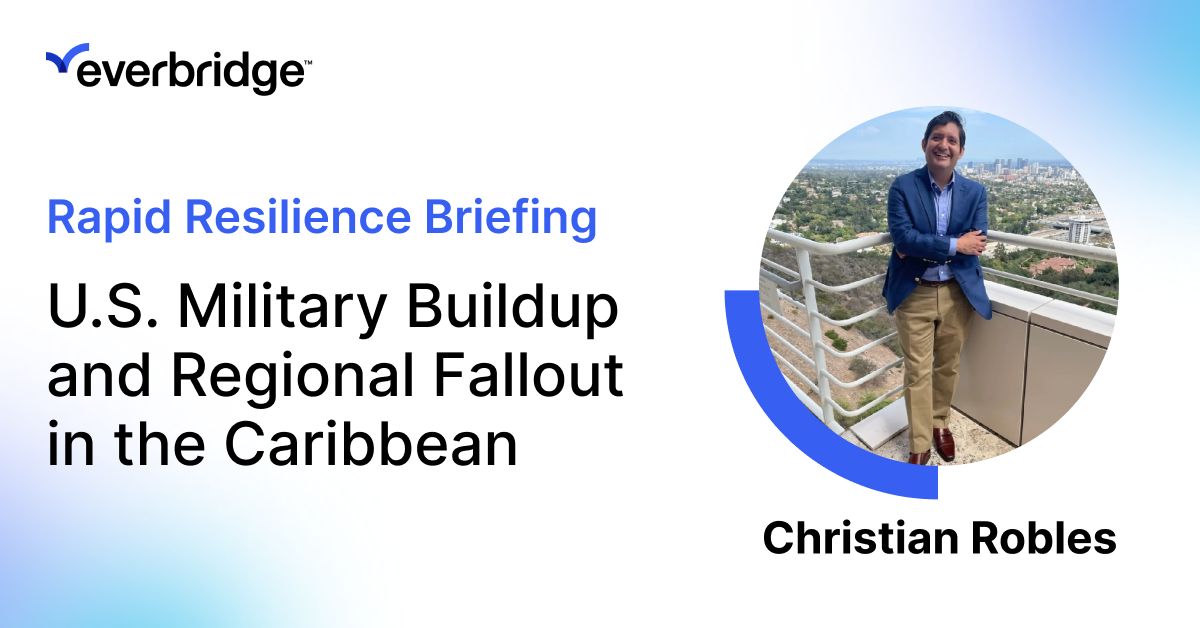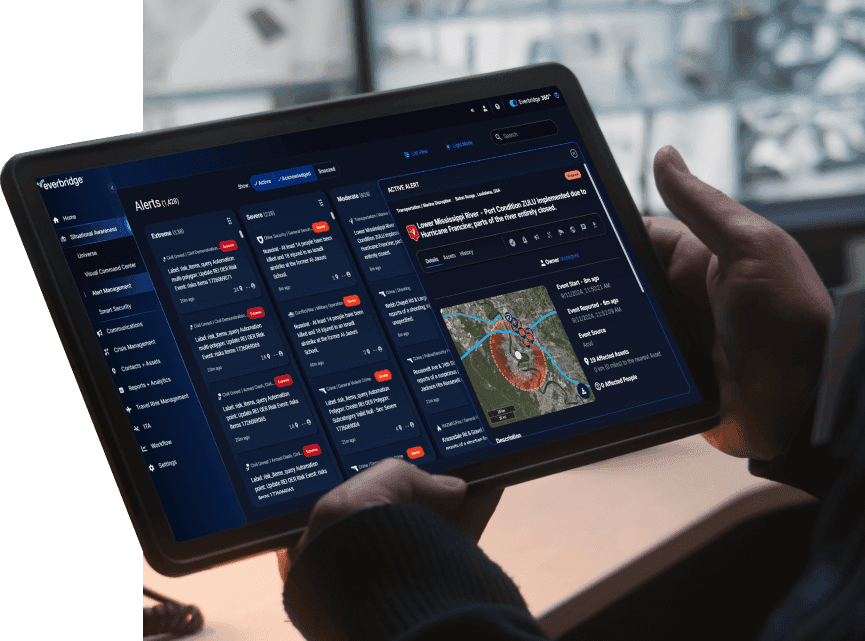Full transcript
[00:04.9] Everybody, my name is Adam DeLuca. I'm the director of Risk Intelligence here at Everbridge. I know I've been popping on these a lot lately, but unfortunately, things, continue to happen, that we need to highlight, for our customers and partners. Just last night, gunman attacked a Hanukkah celebration at a popular tourist spot in Australia called Bondi beach. [00:28.3] They killed 11 people in an act of anti Semit. And obviously there's been a wave of anti Semitism in Australia over the past years with vandalism and attacks, on the rise throughout the country. It's the deadliest shooting in Australia in almost three decades. [00:46.0] One suspect is in custody, the other is dead. It occurred just hours after another shooting at Brown University, where an individual who's still at large opened fire in a school building, killing two and injuring dozens of other students. [01:04.0] These are horrible and sad events, but unfortunately they continue to happen. Violent extremism, something that we've talked about many times, it is cheap, it's easy to conduct, and it's very tough to detect and deter. Once an individual is motivated by ideology or something else, they're very difficult to stop. [01:23.9] And I still think organizations are overlooking this as a threat. There are things that you can do to mitigate these risks. In spite of these being cheap, easy and difficult to detect, you can conduct vulnerability and threat assessments. You need to identify your high value targets and your high value events. [01:42.5] You need to continue monitoring and understand tactics, tradecrafts and procedures like vehicle rammings, especially around this time of year. For Christmas markets in Europe and other outdoor events. You need to leverage dark web monitoring and good open source intelligence so you understand the threat landscape. [01:59.4] You need to harden perimeters, control access. You need to randomize security patterns to make yourself and your security less predictable. And you need to enhance your partnerships with law enforcement. And these are all things that you can do to mitigate these risks and keep your people safe this time of year with all these high profile events happening. [02:19.5] So, I hope everybody stays safe and has a great rest of the weekend here at Everbridge. We'll continue to monitor and provide updates as necessary. I hope everybody has a great day.
Full transcript
[00:04.9]
Hey, everybody. My name is Adam DeLuca. I’m the director of Risk Intelligence here at Everbridge. It’s good to be with you all today. I’m here with Ignacio Brarda. He is our deputy CISO here. And looking back on the last year, we just wanted to have a conversation with him about cyber security.
[00:20.4]
It’s obviously a big issue, with organizations right now, and I wanted to bring Ignacio to talk about it. So thank you very much for being here. Yeah, thank you, Adam. Excited to be here. Great. So, you know, just kind of looking back over the last year with how active the cybersecurity threat landscape was, what would you identify as maybe a significant trend or cybersecurity incident that was a real inflection point for the threat landscape?
[00:47.3]
Yeah, that’s. That’s an excellent question, because there’s definitely a lot going on this past year. But something that was very unique to, to 2025, I would say, is that we had the first reported AI orchestrated cyber espionage campaign. Right.
[01:02.5]
And in there, this is a, before and after, I think, in the industry, because bad actors are starting to use agents to do these attacks for them. Right. And so if you think right, like, bad actors organize themselves, they create their own enterprises.
[01:20.8]
But what’s different now is that by leveraging AI and these technologies that were designed, for good, they’re using them from the wrong reasons. And this means that they have an army of 24 by seven agents that can produce these attacks for them.
[01:39.9]
We know that the technology landscape is very complex. You need a lot of expertise in different areas. But just like AI helps us understand technologies better, it’s also helping these attackers quickly become experts and finding exploits on different technologies that are out there.
[01:56.0]
And with the help of AI agents, they can automate that and be constantly knocking at your door trying, to find how to get in. Yeah, it just makes them faster and more efficient and, you know, be able to change the adversary behavior and targeting and their capabilities.
[02:12.7]
Especially with the, geopolitical nation state actors, the Volt typhoon campaigns, and ransomware for a service. I think AI is just going to accelerate all that and make it that much more difficult for organizations to kind of defend against it. But again, to the ransomware point, we talk about ransomware and we talk about phishing, denial of service attacks, but what are some of the emerging cyber trends in 2026 that might not be top of mind yet for organizations?
[02:41.5]
Yeah, I think part of that is going to be Being able to respond before it was with automation and APIs, you know, it was responding at the speed of machines. Now with the AI, it’s going to be responding at the speed of AI.
[02:56.8]
And this is, a component that’s adaptive. Right. For teams. So if you think about it before, being good at security is not good enough anymore. Right. You need to take that extra level that before only certain enterprises and industries were able to get to, which is being adaptive.
[03:14.5]
How do you adapt? Attacks are going to be being modified as they start getting through defenses now. Right. With the help of AI, you know, malware can mutate in order to find the ways to get through the different defense layers. So I think, you know, besides your ransomware, your phishings, we need to be very careful with adaptive attacks.
[03:35.8]
I think they’re changing as, as they go and as they make it through your organization, in order to be ready for that. It’s kind of like fighting fire with fire. Attackers are using AI to do this, while organizations are going to have to be better at using AI to prevent them from leveraging these adaptive attacks.
[03:57.2]
So what are some ways to do that? Zero trust architecture, proactive red teaming. What are some of the uses that you could use AI for to defend against, against some of these attacks? Yeah, that’s an excellent question, Adam. I think one of them is when you look at your user behavior and even taking a step farther, your services and machine behaviors, using machine learning to understand that behavior.
[04:24.0]
So that whenever something steps away from that predefined, baseline that you have built for either that user identity or system, you can quickly identify that and have the team respond to it. Right.
[04:39.0]
And a lot of that response going to be automated in some way. Right. So you’ll have to define, I think enterprise teams are going to, are going to have to define where the risk appetite is and how much they want to let these AIs respond to these attacks for them.
[04:57.3]
Because there’s definitely risk associated with that too, right? Well, yeah, it’s not about risk avoidance. Right. It’s about risk prioritization and making sure that you’re taking on the amount of risk for certain vulnerabilities. But I think everybody’s going to want to know what’s next.
[05:13.2]
So you just touched on that. But how might organizations go about prioritizing improving their cyber posture going forward with the dynamic threat of AI and with the increased presence of nation state actors in these threat groups? Yeah, yeah.
[05:29.5]
And you know that I like, I really like that last part. Of your question, you know, state actors and threat groups, the way organizations can defend against those very advanced threats and persistent threats is really identifying what the crown jewels are.
[05:46.1]
Right. One of the key things I think for 2026 is going to be really locking down those crown jewels, really putting the focus where what are those systems, people, processes, data that are making your business money, that are critical to your operation and making sure that you’re able to protect them with the right technologies in there.
[06:07.3]
As we see the world becoming more and more digital, the landscape is growing and the amount of systems, it’s rapidly increasing. So really understanding what are my crown jewels, what are the systems that are making money to my organization that I, you know, we need to protect everything.
[06:26.3]
But my focus needs to be very adaptive, in these specific systems for my organization. So I do think, you know, CISOs and security experts are going to have to continue to work their, their business hat right. And really understanding what’s critical for, for the business and how can I protect that in 2026.
[06:44.9]
Yeah, it’s not just for cyber. It’s identifying unacceptable consequences based off of threat environment and adapting. So, you know, tabletop exercises, not just good cyber hygiene, but, you know, because the way people are attacking and going about exploiting information now is just so diverse and complicated.
[07:04.2]
Ignacio, it was great for you to take the time out today and join us on the rapid resilience pod. Anytime. You’re happy to come on and talk to us about cybersecurity, hygiene or anything else. We really appreciate the partnership over the last year. Excellent. Thanks, Adam.
[07:19.9]
All right, thanks, Ignacio.
Collapse
Full transcript
[00:04.9]
Hello, my name is Wyatt Kinney and I’m the Everbridge Global Insights team’s regional analyst for Asia Pacific. Today I’ll be providing a brief update on renewed military tensions along the Thailand and Cambodian border and what this escalation means for organizations operating in the region.
[00:21.3]
On December 8th Thailand carried out airstrikes against Cambodian military positions near the contested areas of Pre Vaheer and Tamu. And Tom, Thai authorities say the strikes were a defensive response after Cambodia deployed long range rocket systems close enough to threaten Thailand civilian areas.
[00:39.5]
Cambodia reports at least four civilian deaths, additional injuries and damage to infrastructure in the area that was impacted. Both governments initiated evacuations along the border following the strikes. This marks the most serious escalation between the two countries south since mid-2025.
[00:57.0]
Why does this matter? These strikes are part of a broader pattern of instability throughout 2025, including exchanges of fire between the two sides earlier this year in May, civilian confrontations in September along the border which included protests and a landmine blast in November that disrupted the Kuala Lumpur Peace Accord which was a US and Malaysia facilitated framework designed to help Thailand and Cambodia manage border incidents, coordinate troop movements, support joint de mining within the area.
[01:27.3]
The implementation of this peace report has been uneven as we’ve seen further escalations since it’s been implemented. At the same time the communication channels meant to prevent escalation are underdeveloped or inconsistent. Without reliable joint investigation or de escalation tactics, even routine troop movements from either side can be seen as hostile actions.
[01:51.3]
So the core of what drives the tension between the two countries, the International Court of Justice in 1962 ruled that the pre of a year of temple belongs to Cambodia. But the ruling did not clarify the surrounding territory, leaving the border ambiguous and highly dispute prone.
[02:10.8]
Domestic politics play a role as well. Thai security institutions emphasize rapid decisive responses. Cambodia faces a strong sovereignty expectation from communities living near the contested area. External actors also shape the tension.
[02:27.7]
The US and Malaysia continue to support the Kuala Lumpur process in the peace accord. Cambodia’s close relationship with China adds additional geopolitical weight to its own decision making when these disputes occur. So impacts on business operations.
[02:45.2]
For companies operating in northeastern Thailand or northwestern Cambodia, this escalation affects logistics, workforce mobility, regulatory processes and project timelines. Cross border checkpoints already seeing slower processing and heightened inspections.
[03:02.0]
Manufacturing zones reliant on cross border flows including textiles, footwear, electrical components, automotive components. It’s possible they’ll see production delays and the need for higher inventory buffers, Cambodian nationals working in Thailand may face tighter document checks, leading to temporary workforce gaps.
[03:22.1]
Infrastructure and development projects near the border, especially those requiring surveys or demining, may experience pauses or restricted access. Even administrative processes such as Cambodia’s recent e visa changes are adding uncertainty to the digital and regulatory workflows.
[03:40.5]
So, an outlook for this situation in the next 48 to 72 hours. Continued tension along the border, no doubt. Hopefully no indication of intentional escalation. But like we talked about before, you know, even a simple troop movement could spark something. The lack of joint monitoring keeps misinterpretation risks elevated.
[04:00.8]
Certainly, over the next two to six weeks, fragile standoff is most the most likely scenario. Even with occasional incidents, uneven diplomatic engagement, organizations should anticipate recurring operational variability, over the next six to 12 months going into 2026, the core issues are going to remain, which includes an unclear border, leftover mines, and weak coordination between the two governments.
[04:32.4]
Unlikely, to be resolved, be resolved quickly. Because of that, even without a full scale conflict, the border is expected to remain unstable from time to time or sporadically throughout the next year. So what should organizations do now?
[04:47.5]
Companies should ensure their business continuity plans allow rapid adjustments to routing, staffing, and facility access. Alternate transport corridors either through Laos, Vietnam, or other maritime routes may be needed if tensions increase. Non essential travel near affected districts should be limited.
[05:05.3]
Essential personnel should receive vetted route guidance and reliable communication tools. And finally, communication with staff, partners, and investors should remain factual and neutral, Given the sensitivity of the territorial issues. Thank you so much.
[05:20.6]
We’ll continue to monitor the situation closely. Have a great rest of your day.
Full transcript
00:05
Hello, my name is Christian Robles and I’m the regional analyst for Latin America in the Caribbean here at Everbridge. We’ve been following this story since mid August when reports first surfaced that the US was deploying naval and air assets into the southern Caribbean.5sAdd a noteJump to
00:22
Early positioning framed as a counter narcotics buildup against so-called narot terrorists in the region. Two months later, that buildup has become a live operation. The US has now conducted 10 confirmed strikes. Eight in the Caribbean Sea and two in the Eastern
00:40
Pacific, killing at least 43 people and capturing two others. The latest strike hit a Drenad Aagua vessel in international waters. And hours later, Washington ordered the deployment of the Gerald R. Ford carrier strike group into the region under US southern command.
01:02
This marks a turning point. What began as targeted interdictions is now a full-scale power projection in the Western Hemisphere. And looking ahead, if this continues, several outcomes are possible. First, the operation could expand beyond the sea. President Trump has said he
01:22
won’t seek a declaration of war and that land operations will be next. That raises the prospect of covert actions inside Venezuela or air strikes on inland targets. Redrawing the map of US engagement in South America. Second, regional alignment is hardening. Colombia accuses Washington of
01:45
extrajudicial killings while Venezuela is mobilizing forces along its borders and warning of asymmetrical warfare. Meanwhile, Trinidad and Tobago is moving the other direction, hosting the destroyer USS Graveley and 2,000 Marines this week for joint exercises. The
02:05
island has become Washington’s southern anchor, a forward partner now facing greater exposure to Venezuelan cyber and intelligence pressures. And third, the commercial impact for shipping energy and insurance. The southern Caribbean is shifting from a patrol zone to a contested operating environment.
02:29
It’s expected temporary port closures in Trinidad and Tobago, higher war risk and detention premiums within 200 nautical miles of Venezuelan waters and strict sanctions screenings as the US expands terror designations. If exclusion zones appear or if Venezuela begins shadowing commercial
02:49
traffic, markets will react quickly. Since August, this campaign has evolved from deterrence to execution. The language deployments and now the carrier group all signal a sustained operational phase. If the tempo continues, the next step could move Finland. A shift that would
03:09
rattle regional stability and the confidence of US companies moving goods, fuel or data through these routes. We’ve been covering this from all angles and the takeaway is clear. We recommend monitoring unfolding events. Each new strike, asset movement signals that this
03:30
operation isn’t slowing, and the longer it runs, the harder it becomes to unwind. I’m Christian Robas, and we’ll continue tracking how these developments shape risk and stability across the region in the days ahead.










